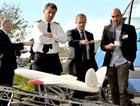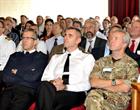Royal Navy helping drive the future of unmanned aviation
The Royal Navy continues to sail ahead in the world of new technology bringing together military and industry for a two day conference on unmanned aviation.
More than 150 military, experts and industry leaders converged on RNAS Culdrose in Cornwall – the home of the Royal Navy’s unmanned aircraft squadron, 700X – to look at how autonomous systems can be used on the battlefield of tomorrow.
It comes a year before the Royal Navy stages its first exercise dedicated to the use of unmanned air, sea and underwater vehicles, off Scotland, in October 2016.
Ahead of that the Royal Navy chose to invite the best and brightest from across the civilian and military technological world to see how the two can tap the latest kit to the advantage of the UK’s armed forces.
We have moved from a world where unmanned aircraft really were a pipe dream to those on the front line to one where they are transforming our daily business.
Rear Admiral Keith Blount RN
Industry leaders at the conference included Thales, QinetiQ, Lockheed Martin and the University of Southampton and they took the opportunity to speak about the future development of unmanned air systems and highlight their areas of expertise.
Admiral Sir George Zambellas, First Sea Lord and Chief of the Naval Staff, was keen to stress the importance of technology and innovation for the Royal Navy.
He said: “Developments in automation, 3D-printing, novel weapons and data processing are shaping our maritime future, and spurring UK innovation. The Royal Navy will seize this opportunity with both hands – we will fight and win 21st Century battles with 21st Century technological expertise.
“As the home to the Royal Navy’s first squadron of remotely-operated aircraft, RNAS Culdrose is the Royal Navy’s centre of excellence for unmanned aerial systems and the vanguard of our journey into automation.
“The Maritime Unmanned Air Systems Conference is another exciting step towards this technological future.”
Over the past couple of years, the Navy has delved into the unmanned world: the ‘flying eyes’ of ScanEagle have been used extensively in the Gulf region on board Type 23 frigates; a specialist team in Portsmouth is working to develop remote-controlled and autonomous minehunting craft; and during the summer, the first 3D-printed aircraft was launched from a British warship, HMS Mersey.
Prof Andy Keane of the University of Southampton, who was behind that trial on Mersey, said it was now being extended with three of the 3kg aircraft joining HMS Protector for her six-month deployment surveying the Antarctic over the austral summer.
Rear Admiral Keith Blount, Assistant Chief of Naval Staff (Aviation, Amphibious Capability and Carriers), said the world of unmanned aerial vehicles presented “an intoxicating mix of opportunities.”
He added: “We have moved from a world where unmanned aircraft really were a pipe dream to those on the front line to one where they are transforming our daily business.
“When I was in command of our operations in Bahrain, I watched in awe as we worked with ScanEagle. I was amazed by the potential offered by one small unmanned aircraft.”
RNAS Culdrose was well placed to host the unmanned air systems conference as home to 700XNAS, the unit leading the Royal Navy into the world of unmanned flight.
Captain Adrian Orchard, Commanding Officer of RNAS Culdrose, said: “700X has played a vital part in the Fleet Air Arm’s first step into the world of remotely piloted air systems, and I am proud to say that Culdrose is now considered the home of Royal Navy Maritime UAS capability.
“The annual conference that we launched brought together experts to discuss the future. Working together will benefit everyone, but learning from industry leaders will help us develop our tactics and embrace new technology.”







